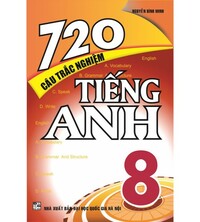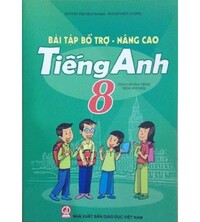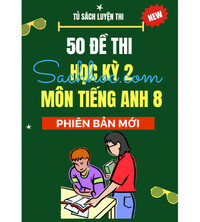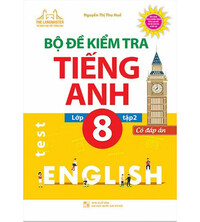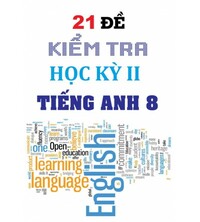Getting started trang 6 Unit 7 SGK Tiếng Anh 8 mới
Chủ đề bài học này khá thú vị, mang tính “thời sự” cao vì liên quan đến sức khỏe và môi trường sống của quanh ta. Đó là sự ô nhiễm.
GETTING STARTED
Bài 1
1. Listen and read
(Nghe và đọc)
A project on pollution
Nick: Your home village is so beautiful. There are so many trees, flowers and birds.
Mi: Yes, that's why I like coming back here on holiday.
Nick: Mi, what's that factory? It looks new.
Mi: I don't know. There wasn't a factory here last year.
Nick: Mi, look at the lake! Its water is almost black.
Mi: Let's go closer. ... I can't believe my eyes. The fish are dead!
Nick: I think the waste from the factory has polluted the lake. The fish have died because of the polluted water.
Mi: That's right. If the factory continues dumping poison into the lake, all the fish and other aquatic animals will die.
Nick: Ahchoo!
Mi: Bless you! What's the matter?
Nick: Thanks. Ahchoo! I think there's air pollution here as well. If the air wasn't dirty, I wouldn't sneeze so much. Ahchoo!
Mi: I've come up with an idea about our environmental project! How about giving a presentation about water and air pollution?
Nick: That's a good idea. Let's take some pictures of the factory and the lake to illustrate our presentation. Ahchoo!
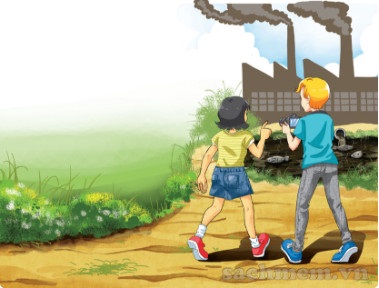
a. Find the word/ phrase that means
(Tìm một từ/ cụm từ mà có nghĩa:)
1. no longer alive
2. growing or living in, on, or near water
3. throwing away something you do not want, especially in a place which is not allowed
4. a substance that can make people or animals ill or kill them if they eat or drink it
5. made unclean or unsafe to use
6. to think of an idea, or a plan
b. Answer the questions.
(Trả lời các câu hỏi.)
1. Where are Nick and Mi?
2. What does the water in the lake look like?
3. Why is Mi surprised when they get closer to the lake?
4. What is the factory dumping into the lake?
5. Why is Nick sneezing so much?
c. Tick (✓) true (T), false (F), or no information (NI)
(Chọn đúng (T) hay sai (F), hoặc không có thông tin (NI).)
|
|
T |
F |
NI |
|
1. The water in the lake has been polluted by a ship. |
|
|
|
|
2. Water pollution in the lake has made the fish die. |
|
|
|
|
3. Aquatic plants may also die because of the polluted water. |
|
|
|
|
4. Nick wouldn't sneeze so much if the air was clean. |
|
|
|
|
5. Nick and Mi will give a talk about water and air pollution. |
|
|
|
Phương pháp giải:
Dịch bài hội thoại:
Nick: Làng quê của bạn thật đẹp. Có nhiều cây, hoa và động vật.
Mi: Đúng vậy, đó là tại sao mình thích trở về nơi đây vào mỗi kỳ nghỉ.
Nick: Mi à, nhà máy đó là gì vậy? Trông nó mới nhỉ.
Mi: Mình không biết. Năm rồi không có nhà máy nào ở đây cả.
Nick: Mi, nhìn cái hồ kìa! Nước của nó gần như đen thui!
Mi: Chúng ta lại gần xem... Mình không thể tin vào mắt mình nữa! Cá chết rồi!
Nick: Mình nghĩ chất thải từ nhà máy làm ô nhiễm hồ đấy. Cá chết bởi vì nước ô nhiễm.
Mi: Đúng rồi, nếu nhà máy tiếp tục gây độc hại nguồn nước. Tất cả cá và những động vật dưới nước sẽ chết.
Nick: Ahchoo! (Tiếng hắt xì)
Mi: Cầu Chúa phù hộ cho bạn! Chuyện gì vậy?
Nick: Cảm ơn. Ahchoo! Mình nghĩ rằng có sự ô nhiễm không khí nữa. Nếu không khí không ô nhiễm, mình không hắt xì nhiều như vậy đâu. Ahchoo!
Mi: Mình có một ý kiến về một dự án môi trường! Chúng ta hãy trình bày một bài thuyết trình về ô nhiễm nước và không khí!
Nick: Ý kiến hay. Chúng ta hãy chụp vài bức hình về nhà máy và hồ để minh họa bài thyết trình của chúng ta. Ahchoo!
Lời giải chi tiết:
a)
1. no longer alive = dead
(không còn sống = chết)
2. growing or living in, on or near water = aquatic
(lớn lên hoặc sống trong hoặc gần nước)
3. throwing away something you do not want, especially in a place which is not allowed = dump
(ném đi thứ gì mà bạn không muốn, đặc biệt là ở nơi mà không được cho phép = thải)
4. a substance that can make people or animals ill or kill them if they eat or drink it = poison
(một vật mà có thể làm cho người hoặc động vật bị bệnh hoặc giết chúng nếu chúng ăn hoặc uống nó)
5. made unclean or unsafe to use = polluted
(làm cho không sạch hoặc không an toàn khi sử dụng)
6. to think of an idea or a plan = to come up with
(nghĩ về một ý tưởng hoặc một kế hoạch)
b)
1. They are in Mi’s home village.
(Nick và Mi ở đâu? => Họ đang ở làng quê của Mi.)
2. It’s almost black.
(Nước ở trong hồ trông như thế nào? => Nó gần như đen.)
3. She’s surprised because she sees the fish dead.
(Tại sao Mi ngạc nhiên khi đến gần? => Cô ấy ngạc nliiễn bởi vì cô ấy thấy cá chết.)
4. It’s dumping poison into the lake.
(Nhà máy xả thải cái gì xuống? => Nó xả chất độc xuống hồ.)
5. He’s sneezing so much because the air is not clean.
(Tại sao Nick hắt xì nhiều? => Anh ấy hắt xì nhiều bởi vì không khí không sạch.)
c)
1. F
(Nước trong hồ bị ô nhiễm bởi một con tàu.)
=> It’s polluted by the factory.
(Nước bị ô nhiễm bởi nhà máy.)
2. T
(Ô nhiễm nước trong hồ đã làm cá chết.)
3. NI
(Thực vật dưới nước có thể chết vì ô nhiễm nước.)
4. T
(Nick sẽ không hắt xì nhiều nếu không khí sạch.)
5. T
(Nick và Mi sẽ có một bài nói về ô nhiễm nước và không khí.)
Bài 2
2. There are different types of pollution. Write each type under a picture.
(Có sự khác nhau về loại ô nhiễm. Viết mỗi loại dưới một bức hình.)
|
water pollution |
land/soil pollution |
air pollution |
|
noise pollution |
thermal pollution |
light pollution |
|
radioactive pollution |
visual pollution |
|
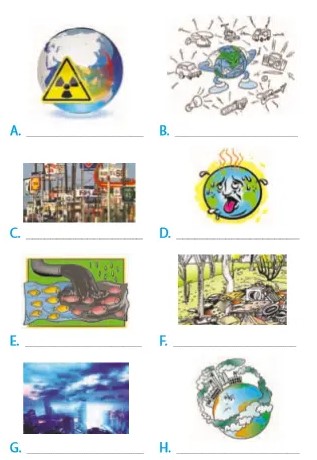
Lời giải chi tiết:
1. radioactive pollution: ô nhiễm phóng xạ
2. noise pollution: ô nhiễm tiếng ồn
3. visual pollution: ô nhiễm thị giác — tầm nhìn
4. thermal pollution: ô nhiễm nhiệt
5. water pollution: ô nhiễm nước
6. land/soil pollution: ô nhiễm đất
7. light pollution: ô nhiễm ánh sáng
8. air pollution: ô nhiễm không khí
Bài 3
3. Complete the sentences with the types of pollution.
(Hoàn thành câu với những loại ô nhiễm.)
1. When happens, the water temperature in streams, rivers, lakes, or oceans changes.
2. occurs when the atmosphere contains gases, dust, or fumes in harmful amounts.
3. When radiation goes into the land, air or water, it is called .
4. Too much use of electric lights in cities may cause .
5. is the contamination of lakes, rivers, oceans, or groundwater, usually by human activities.
6. happens when human activities destroy the Earth's surface.
7. occurs because there are too many loud sounds in the environment.
8. The sight of too many telephone poles, advertising billboards, overhead power lines, or shop signs may cause .
Lời giải chi tiết:
|
1. thermal pollution |
2. Air pollution |
3. radioactive pollution |
|
4. light pollution |
5. Water pollution |
6. Land/ Soil pollution |
|
7. Noise pollution |
8. visual pollution |
1. thermal pollution: ô nhiễm nhiệt
When thermal pollution happens, the water temperature in streams, rivers, lakes, or oceans changes.
(Khi ô nhiễm nhiệt xảy ra, nhiệt độ nước ở suôi, sông, hồ và đại dương thay đổi.)
2. Air pollution: Ô nhiễm không khí
Air pollution occurs when the atmosphere contains gases, dust, or fumes in harmful amounts.
(Ô nhiễm không khí xảy ra khi không khí chứa khí, bụi hoặc hương với số lượng nguy hại. )
3. radioactive pollution: ô nhiễm phóng xạ
When radiation goes into the land, air or water, it is called radioactive pollution.
(Khi phóng xạ đi vào đất, không khí hoặc nước được gọi là ô nhiễm phóng xạ. )
4. light pollution: ô nhiễm ánh sáng
Too much use of electric lights in cities may cause light pollution.
(Sử dụng quá nhiều ánh sáng điện tử trong thành phố có thể gây ô nhiễm ánh sáng. )
5. Water pollution: Ô nhiễm nước
Water pollution is the contamination of lakes, rivers, oceans, or groundwater, usually by human activities.
(Ô nhiễm nước là sự nhiễm độc của hồ, sông, đại dương hoặc nước ngầm thường do hoạt động của con người. )
6. Land/ Soil pollution: Ô nhiễm đất
Land/Soil pollution happens when human activities destroy the Earth’s surface.
(Ô nhiễm đất xảy ra khi những hoạt động của con người phá hủy bề mặt Trái đất. )
7. Noise pollution: Ô nhiễm tiếng ồn
Noise pollution occurs because there are too many loud sounds in the environment.
(Ô nhiễm tiếng ồn xảy ra bởi vì có quá nhiều âm thanh lớn trong môi trường. )
8. visual pollution: ô nhiễm tầm nhìn
The sight of too many telephone poles, advertising billboards, overhead power lines, or shop signs may cause visual pollution.
(Cảnh quá nhiều cột điện thoại quảng cáo pa nô, dây điện trên đầu, hoặc bảng hiệu cửa hàng gây ra ô nhiễm tầm nhìn. )
Bài 4
4. Work in groups. Which types of pollution in 3 does your neighbourhood face? Rank them in order of seriousness. Give reasons for your group's order.
Vote for the group with the best reasons.
(Làm theo nhóm. Loại ô nhiễm nào trong phần 3 mà xóm bạn đối mặt? Sắp xếp mức độ nghiêm trọng. Đưa ra lý do cho thứ tự nhóm.)
Lời giải chi tiết:
It’s air pollution, noise pollution and visual pollution.
Air pollution —> noise pollution —> visual pollution
Air pollution does harm to your health. Noise pollution can make you stressed. Visual pollution is not good for sight around.
Tạm dịch:
Đó là ô nhiễm không khí và ô nhiễm tiếng ồn và ô nhiễm tầm nhìn.
Ô nhiễm không khí gây hại cho sức khỏe. Ô nhiễm tiếng ồn có thể làm bạn căng thẳng. Ô nhiễm tầm nhìn không tốt cho khung cảnh xung quanh.
Từ vựng
- factory (n): nhà máy
- dead (adj): chết
- waste (n): rác thải
- pollute (v): gây ô nhiễm
- dump (v): thải ra
- poison (n): chất độc
- aquatic animal: động vật biển
- dirty (adj): bẩn
- sneeze (v): hắt xì
- illustrate (v): minh họa
- presentation (N): bài thuyết trình
- radioactive pollution: ô nhiễm phóng xạ
- noise pollution: ô nhiễm tiếng ồn
- visual pollution: ô nhiễm thị giác — tầm nhìn
- thermal pollution: ô nhiễm nhiệt
- water pollution: ô nhiễm nước
- land/soil pollution: ô nhiễm đất
- light pollution: ô nhiễm ánh sáng
- air pollution: ô nhiễm không khí
Search google: "từ khóa + timdapan.com" Ví dụ: "Getting started trang 6 Unit 7 SGK Tiếng Anh 8 mới timdapan.com"
